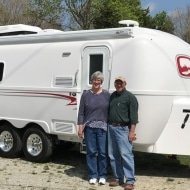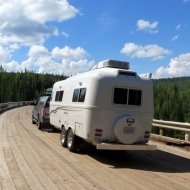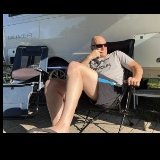Leaderboard
Popular Content
Showing content with the highest reputation on 08/02/2018 in all areas
-
My ‘17 Tundra tailgate would hit the Bulldog latch. The truck would sag under load but the trailer was level using the Anderson in it’s highest position. I installed the Firestone air bags to level the truck and was able to lower the hitch one hole so that the trailer is still level. The tailgat now clears by a couple inches. I didn’t have to make much if any change to the Anderson adjustment due to the fact that the relative position between the hitch and trailer remains the same. The air bags require about 15 pounds for a level truck/trailer. I fabricated a manifold so that I can add air to either side or both air bags and have a built in gauge to check the pressure. I also mounted an old Coleman air compressor next to the manifold for adding air, and plug the compressor in the trailer connector as needed.2 points
-
We picked up our twin bed Legacy Elite II just over 1 week ago. Has the AGM's, solar, Truma AquaGo® Water Heater , fiber granite, etc. - really everything but the Wi-Fi, Satellite stuff, camera's, table, upgrade bedding and cell booster. (5200 lbs. sticker at delivery) I added to my build a spare set of axle replacement seals and bearings, and a complete tire/rim (yes that makes two). So far I have been impressed with the overall integration of the sum of its "parts" into a very functional unit that is well executed. I've run everything but the heat system, plenty of that naturally right now. It is very impressive that Oliver has thought through the process and has included in the delivery the various items needed to actually use the unit - the hoses, adaptors, water pressure reducer, etc. There is a lot to like about the unit, many of you, as owners, know what that is, so my few "complaints" are as follows: 1.Don't understand the shower curtain process - it just doesn't work. Will find a better answer - probably figure out a way to keep water off/out of the Natures Head, and call it a day. 2.Had a small area of unfinished exterior surface prep (about palm size). A little elbow work. 400/600/1200 sandpaper and polish took care of it. 3. After one week of airing it out - the fiberglass and resin smell is still there - I expect this to diminish over time. Yes the AC is loud - but that was expected. The "22” Flat Screen LCD TV, Radio with FM & AM Dual Zone Audio Output, CD/DVD/MP/WMA/MP4, USB, Bluetooth & Remote Control" - whew -works much better than I expected, and the lighting and switch options ae really well done. The DC/usb port lights are annoying if you don't plug in the rubber cover. That's about it - so far. I have installed magnets to keep the bathroom door open, used 3m double side tape - works great. Re engineered my Thule bike rack to install on the rear of the Ollie. It works well and looks very similar to the former factory option. As they discontinued the factory option. Interesting that the tow cable hooks are too large to fit the hitch attachment locations on my GMC. Had to buy some heavy duty large carabiners to make the transition. I Amazoned a box of the recommended grease, a new dedicated grease gun, the Anderson wheel chocks, and the door magnets. Still have to source spare fuses - by the way, Oliver is now putting 2 amp fuses in the Natures Head circuit. I purchased a Gushill lock for the bulldog hitch, and also lock the leaver - thus theft now represents to much trouble - the thieves will move on to the next rube. Or unbolt the Bulldog…. Did you know Dometic fridge/freezer maintains 40 degree at setting 2. Inquiring minds and all. And the Heat/cool T stat is accurate - within reason. Towing was fine, The Anderson worked as advertised, but I have sourced a new TV, perhaps overkill with the 2500, but hey, a man and his toys. (Cindy likes the truck - a bonus) That's it - a satisfied owner - to date. As an aside - the purchase price for these units is hard to justify - unless and until you go through the details of the build, the standard options, and the execution. Take it home, crawl around, crawl underneath, poke it, pull it, use it - the value becomes much more compelling. With that - to all a good day!1 point
-
I want to ask Dometic Penguin II owner's about the noise level then your AC is running. While I am very happy with the cooling performance on our unit, especially here is sunny Florida, the noise is overwhelming. When the AC kicks in and we are watching the TV and with the audio turned up all the way, we can't hear it. While I can pump the TV audio through the four speakers to fix this situation somewhat, it is very distorted at best. I have read the threads in the forum regarding AC noise but found no real answers. I also searched the web and dometic.com for noise issues around the Dometic Penguin II but, can't find anything other then what a great improvement this unit is over older ones. That may be true, but I hope not. Would appreciate your thoughts on this issue. Thanks,1 point
-
The optional 2000 watt onboard inverter is a great option to have if you like to get off-grid or even if you have a lengthy drive to get where you are going. The way the optional on-board inverter works is by taking battery (DC) power and converting it over to (AC) 110 power. It is tied to the campers 110 receptacles and microwave to provide power for use when a shore connection isn’t available. However, the inverter does depend on the battery power and it can only provide up to about 15 – 16 amps of power at a single time. This means that if the battery power is too low then some of the more high power consuming devices/appliances may not work properly or simply overload the inverter and cause it to shut down. There are many different appliances out on the market that range from low power consumption to high power consumption and this is important when purchasing these items for use with the inverter option. Hair dryers are a great example of an appliance that demands a lot of power, but also have a broad range of rating. They typically range from 800-1800 watts. While an 1800 watt hair dryer might be the best choice for your house, it will likely require more power than you might want in your camper, especially when running on the inverter. Another example of high power consumption is the microwave. It uses 12 amps, which is getting close to the 15-16 amp max for the inverter. Just keep this in mind when running the microwave as turning on another appliance at the same time might cause the inverter to shut down. What does the inverter need to work properly? The inverter is 100% dependent on the battery bank power, so be sure that the batteries are always charged up and ready for use if you plan to use the inverter. When purchasing the inverter option it is crucial that you also get the solar package or some form of charging solution so it can keep the batteries charged up and ready to go. The battery bank on the camper also needs to be able to hold enough power to supply the power demand from the inverter and appliances connected. The optional 6V AGM batteries can provide about 200-250 amp hours which is a substantial increase from the standard 12v batteries. The lower the battery voltage, the less likely the inverter will be able to sustain the power needs of the appliances in use. Also keep in mind that over time your batteries age and lose the ability to hold as much power as they did when they were new. This will also start to impact what you can run on the inverter as well as how long it will run on the inverter. The conversion rate from DC power to AC power is also important to know as this will change the rate at which the batteries can provide power to the inverter and the rest of the camper. If the microwave pulls 12 amps of AC power then it will use about 122 amps when using the inverter and battery bank. What this means is that it is draining your 200 useful battery bank amps rather quickly. However, most people don’t run their microwave but for short periods of time so this high power consumption shouldn’t create a problem. What might cause a problem would be running an appliance like a space heater on the inverter as you might leave it running over a longer period of time and it would eventually drain the battery bank down low enough where the inverter would shut down. The inverter is a great option to have if you think you will be camping off-grid with the solar panel package and without shore power or even if you just want to pull over for a quick break to heat up something in the microwave while traveling to your next camping destination!1 point
-
Telesteps ladder. Amazon has them. Beware of the “other brands” that may fail or are flimsy. The model that I purchased was the OSHA approved model that has a higher weight rating and seems to be a little stronger.1 point
-
You guys are talking gibberish and confusing everyone. The fix is simple to reinstall. Simply, insert it into the source from which it immenated before the release mechanism had been depressed. Malcolm1 point
-
1 point
-
Perhaps Scuba, but according the build documents located remotely, in the cloud, stored on a solar powered processing unit,located in a dimly lit warehouse, hiding in a nondescript city, tucked away in northern outer Mongolia, guarded by well trained blind attack lizards, what appears to be a metal washer, is not listed in the build documentation. I suspect it fell off a lesser unit - some sort of ilk, say Airstream. But I'm just guessing here.1 point
-
That looks like a washer from the right side sprocket on the mucket mill transducer located just aft of the Gbic expansion module on the port side. You'll need a metric left handed wind-up wrench to properly reinstall it. Make sure the back side of the washer is facing out and don't over tighten the retaining ring.1 point
-
The WeBoost cell booster will definitely improve the performance of the jetpack as a hotspot. The cell booster will mean faster speeds, and at locations with poor cell tower connectivity, the cell booster can mean the difference between a connection and no connection. The cell booster will also improve your the signal on your phones. The antenna for the booster is usually placed above the dinette table, so that is where you want to use your cell phones or place your jetpack. Reed and Karen reported problems at the back of the trailer getting signals from the cell booster. Having a JetPack should help that, with an advertised range of about 30 feet; note that obstacles, such as trailer walls, will diminish that range. In terms of which Jetpack to get from Verizon, I would recommend the 7730L, which gets the best reviews for speed. The AC791L model has longer battery life, which is important if you are keeping the hotspot in a daypack as you go about your day, but that is not an advantage if your use is in an Ollie where you can easily keep it charged. Some advice on properly using the cellular booster. After you turn on the WeBoost you should briefly put the phone in airplane mode, and then turn off airplane mode. This forces the phone to let go of the distant cell tower with the weak signal, and to now look for the closest “cell tower,” which is the WeBoost. Similarly, if you were using the JetPack in the tow vehicle, you should power it off and then back on after starting the WeBoost. If you have been out hiking all day, your phone will remain connected to the distant cell tower, and you can get it to connect to the WeBoost by cycling into and out of airplane mode. If all of your internet connections will be via cellular signal and the jetpack, then you have no need for the WiFi Ranger. If, however, you will sometimes be using WiFi (like when the crappy campground WiFi is faster than the weak cellular signal), then the WiFi Ranger has some real advantages. First, the WiFi Ranger has an antenna on the roof and connects to a WiFi source (i.e. campground or Starbucks) much better than your device, such as a phone or a laptop, could on its own. You get a stronger signal and faster speeds. There are several other advantages to the WiFi Ranger. First, it makes connecting much easier if you have multiple devices. (We travel with two iPhones, two iPads, and a laptop.) With one of your devices you connect to the WiFi Ranger, tell it to connect to Campground X WiFi, and give it the password. You do not need to put the Campground X password into the other devices, because they already know the WiFi Ranger password and immediately connect to the WiFi Ranger. Second, the WiFi Ranger generates a stronger signal than a MiFi device. This means it can transmit its signal a longer distance through obstacles like fiberglass walls than does a Jetpack. This means I can get a strong signal using my laptop at the picnic table outside of the trailer. This is true even if I am am using the Jetpack for internet, with the WiFi Ranger connected to the JetPack, since my laptop is communicating directly with the stronger WiFi Ranger. I have a Verizon Jetpack, which I keep on the dinette table near the WeBoost inside antenna. Here is part of my Campsite Arrival Checklist: • Turn on Cell Amplifier. Cycle phones into Airplane mode and back again to regular. • Turn on Verizon Jetpack. • Turn on WiFi Ranger. Connect WiFi Ranger to either Jetpack or local Wifi. Connecting to the WiFi Ranger Control Panel through a web browser is fairly easy. I have done it on each of my devices, and then bookmarked it so I can get back easily. While on a camping trip one of my browser tabs remains connected to the WiFi Ranger Control Panel. The Control Panel shows the speed of each of the possible connections, say, JetPack vs campground WiFi. If the weather is interfering with cellular signals the crappy campground WiFi may be better. Later in the evening, I can check the Control Panel again, and if the JetPack now has the better signal, I can connect the WiFi Ranger to it. Since all of my devices are connected via the WiFi Ranger, all of them have switched from campground WiFi to JetPack. Hope this helps.1 point
-
I have the Attwood Air Command, the 16K BTU model, which uses two small variable speed motors instead of one monster motor. It starts and runs fine off my Yamaha 2400 watt generator without needing an Easy Start, and it pulls about 11 amps running. It runs fine off a 15A circuit if there are no other large loads. It is EXTREMELY quiet outside, whisper quiet, amazingly quiet. Inside is another story, the fan is obnoxiously loud and the fan stays running when the compressor kicks off. I saw no mention of this in their advertising...they claim “2X quieter, as low as 66dB” . http://www.atwoodmobile.com/images/air-conditioners-brochure.pdf I don’t see any way to avoid the high noise, you are living several feet from the high-speed moving parts and rushing air flow. A ducted system, or a unit mounted as far forward on the roof as possible, makes more sense to me, rather than having it right over the sleeping area! This is an interesting article. .... http://www.beginningfromthismorning.com/mini-split-ac/ I am not aware of ANY small RV certified unit that would work reliably in our small trailers and withstand the rocking and jostling without fracturing the copper freon lines. There are DC coolers out there but they consume an enormous amount of battery power. .... https://expeditionportal.com/forum/threads/finally-a-real-12v-air-conditioner-indel-sleeping-well-cube.142600/ I keep a large bag of earplugs for the very rare ocassions I have to sleep with the AC running. John Davies Spokane WA1 point
-
Knowledge Base Article for proper Winterization - Depending on your location it may be necessary to properly winterize your unit to ensure that freezing conditions do not damage any part of the on board water systems. First lets discuss what components are susceptible to freeze damage which would result in water leaks and potential costly service repairs. Brass Check Valves - These valves are in-line valves that keep water from spilling back out of the water fill ports. These valves will be located on the Fresh Water Line, City Connection Line and the Black Tank Flush Line. Plastic Check Valve - The Dometic Standard toilet has a plastic check valve located at the rear of the toilet. Water Valves - These valves are used to control the flow of water. You may have 2 or 4 valves located next to the water pump, 1 located on the lower shell floor to drain the fresh tank, and 1 located on the black tank flush port line. P-Traps - These are used in the sink and shower drain plumbing lines. It retains water and traps debris that has drained from the sink and prevents it from forming a clog deep within the plumbing system, and stops sewer gases from passing into the camper. Water Pump & Filter - The water pump filter is used to trap debris and keep it from entering the pump and water line system that is delivered to the faucets. PEX Push Fittings - These fittings are used to connect different runs of pex pipe through out the camper. Pex itself is freeze tolerant but these plastic and/or brass fittings are not. Faucets - The kitchen, bathroom and external shower faucets all maintain water at the faucet when in use and thus present a potential freeze issue if not properly winterized. Water Heaters - All water heaters should be fully drained of all water and the bypass valve must be set to winterization/bypass mode. This allows for RV antifreeze to be utilized in the plumbing system without filling the water heater itself. *Proper winterization method to ensure that all components are protected. Drain all water from the system (All tanks, water heaters) Set bypass valve at water heater for winterization mode. Change valve configuration at water pump for winterization mode. Use water pump to draw RV Antifreeze (potable Safe) into the camper. Turn on the kitchen faucet (Cold Line) and run until antifreeze comes out. Change to the Hot line and run until antifreeze comes out. Perform steps 5-6 for the bath faucet. Ensure plenty of antifreeze drains into the P-Traps for the kitchen, bath and shower drains. Flush the toilet until antifreeze starts to fill the bowl. Leave antifreeze in bowl to lubricate seal. Turn off water pump. Connect hand pump with antifreeze to the fresh tank fill connection. Pump at least 3- 4 times. Antifreeze is potable safe and will not hurt if it goes into the fresh tank. Connect hand pump with antifreeze to city connection line, turn external shower cold line on and pump until antifreeze comes through shower faucet. *TIP: It will be hard to pump in the city line if the faucets are closed. Turn cold line off and hot line on, pump until antifreeze comes through shower faucet. Connect hand pump and antifreeze to black tank flush port. (You may have to go inside and turn the in-line valve open to allow the antifreeze to freely pump into the tank. *One pump should be sufficient as we are only protecting the check valve. For 2018 Models and newer you will need 4 pumps to sufficiently protect the new flush port system. This change was put in place to meet new codes for the black tank system ensuring that no backflow of waste water can get inside the water supply line. If you are not certain if your camper is equipped with this new port then pump 4 times to be on the safe side.) FAQs The camper can be used in cold weather applications as long as the furnace is utilized to keep the components warm and above freezing temperatures. If traveling between camp sites during cold weather season it may be necessary to winterize depending on outside temperatures. If water is left in the water heater during freezing temperatures even for short periods of time, it can cause damage. RV Antifreeze is designed to replace water and should NEVER be mixed with water as diluting it will defeat its purpose. 2016-Prior-Elite-II-Valve-Configuration.pdf 2017-Current-Valve-Configuration-Sheet.pdf 18.5-Elite-2017-Current-Valve-Configuration.pdf1 point
-
Recent Achievements














